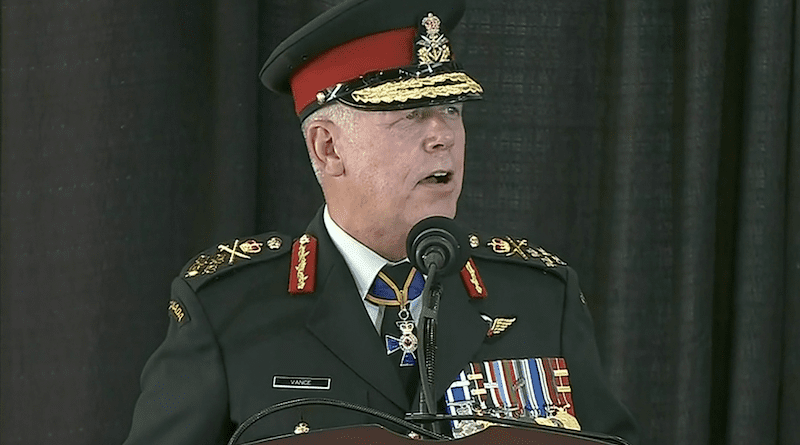The Wrong Path Of Military Communications – OpEd
By Tim Dunne
It wasn’t a significant mutiny — more of a micro-mutiny.
Coming from a 37-year career as a Canadian military public affairs officer, it was my experience that projects undertaken by my former branch would be ordered, structured, disciplined and conform to federal government policy.
So, it was surprising to read Postmedia’s article, Chief of the Defence Staff Gen. Jon Vance and the “weaponization of public affairs,” in the Sept. 21, 2015 edition of the Ottawa Citizen.
In response to Vance’s direction, the Canadian military public affairs organization created the Military Strategic Communication division of the Public Affairs Branch.
The Military Public Affairs Enhancement and Employment Concept described the rationale for the makeover, noting that its current structure “lacks the proper readiness to effectively support overseas operations.”
It noted five deficiencies: insufficient military culture, expertise and readiness; reactive, rather than strategic-driven engagement; ineffectual management of visual communications; lack of innovation; and insufficient Canadian Armed Forces capacity and mindsets.
This was an attempt to establish DND-CAF public affairs as the responsible authority for strategic communication, information operations, influence operations, psychological operations, military deception and other information-related capabilities.
They also implemented several measures as part of the establishment of Military Strategic Communication, which Ottawa Citizen journalist David Pugliese enumerated in his Nov. 2, 2020 article, Canadian military wants to establish new organization to use propaganda, other techniques to influence Canadians:
- The public affairs branch spent more than $1 million to train public affairs officers on “behaviour modification techniques.”
- The new Military Strategic Communication group intended to use the Defence Department’s assigned activities to influence Canadians’ opinions and behaviours.
- Despite the concerns and misgivings of then-defence minister Harjit Sajjan, the communication group staff implemented several planned activities.
- A new research capability was founded to gather and analyze social media content from Canadians, non-governmental organizations, industry and the media.
- Inexplicably, a Canadian military intelligence team monitored and collected information from Ontarians’ Facebook, Twitter and Instagram accounts. They said this was necessary to help the military members who were to work in long-term care homes during the pandemic. This information was passed to the Ontario government as proof that it was failing the elderly in their care.
- The Ottawa Citizen reported in July 2020 the military intended to launch a propaganda campaign to pre-empt civil disobedience during the pandemic, employing similar propaganda processes as they did during the Afghanistan war. Ethical concerns cancelled the program.
- The public affairs branch members were to use personal social media accounts to craft and post pre-approved government and military messages seemingly from the personal accounts of military personnel.
- Public affairs planned to work with military-friendly academics and retired senior military staff to encourage them to promulgate positive messages on social media platforms and in their discussions with reporters.
Public affairs was to be the foundation of a “future information domain capability.” The professional qualifications of their officers were to be augmented by training in information operations and psychological operations. Public affairs officers would use “other information enablers” to support targeting and influence activities during operations and collective training in Canada and against Canadians.
The Policy on Communications and Federal Identity states “Government communications must be objective, factual, non-partisan, clear, and written in plain language. . . . Furthermore, government communication products and activities are timely, accurate, clear, objective, non-partisan, cost-effective, in both official languages, and meet the diverse information needs of the public.”
Vance was careless in calling his direction “weaponization” of public affairs, and later changed this to “operationalization.” But the senior leadership of the military public affairs organization should have known better. This is the bread and butter of the military’s professional public affairs branch, every member of which should have a thorough understanding of the federal policy.
Vance announced his “weaponization of military public affairs” in September 2015. On April 3, 2018, Vance and Jody Thomas, the deputy minister, issued their policy on joint information operations, which should have been seen as an advisory that the public affairs team was on the wrong track.
Senior staff within the Defence Department and the Canadian Armed Forces who should have known better were asleep at the switch for five years and permitted a program that was in contravention of long-standing federal policy.
Finally, on Nov. 5, 2020, Laurie-Anne Kempton, assistant deputy minister for public affairs, passed along Vance’s direction to stop this runaway train, five long years after it began.
More than $1 million was irresponsibly spent on training that should never have taken place and confrontational social media messages that should never have been posted. Senior departmental and military leaders directed wholesale changes to information operations policy. For five years, an untold number of military public affairs personnel were paid for work they should not have been assigned.
In November 2020, the program was cancelled.
Information warfare capabilities are not to be used in Canada, against Canadians.
But Pugliese reported on Jan. 19: “Defence firms and other companies were given almost $10 million to develop new ways to analyze social media and sift through accounts.”
No one appears to have been held accountable for the mismanagement of funds, violations of federal government policy and a micro-mutiny.
Tim Dunne was the longest-serving public affairs officer in the history of the Canadian Armed Forces, serving for 37 years in Canada, the Middle East, Africa, and Eastern and Western Europe.
This article appeared at Saltwire

